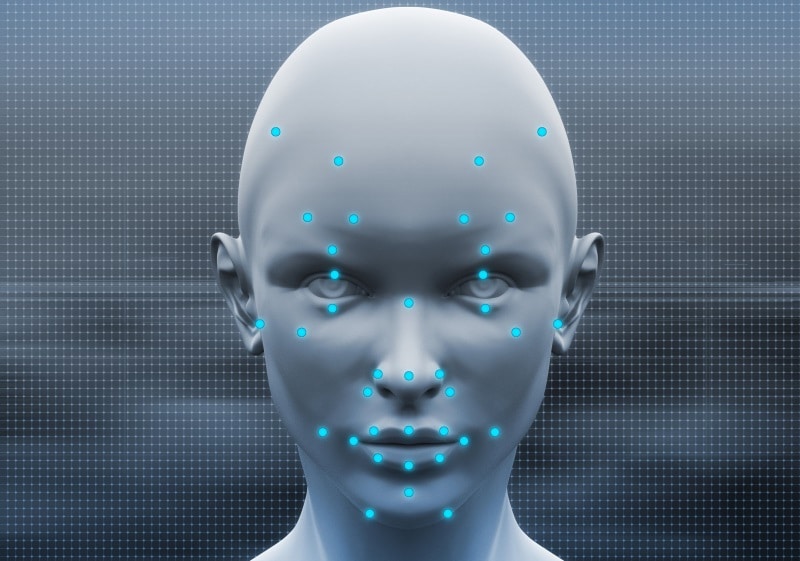A facial recognition system is a technology capable of identifying or verifying a person from a digital image or a video frame from a videosource. There are multiples methods in which facial recognition systems work, but in general, they work by comparing selected facial features from given image with faces within a database.
While initially a form of computer application, it has seen wider uses in recent times on mobile platforms and in other forms of technology, such as robotics.
It is typically used in security systems and can be compared to other biometrics such as fingerprint or eye iris recognition systems.[1]Recently, it has also become popular as a commercial identification and marketing tool.[2]
History of facial recognition technology[edit]
Pioneers of automated face recognition include Woody Bledsoe, Helen Chan Wolf, and Charles Bisson.
During 1964 and 1965, Bledsoe, along with Helen Chan and Charles Bisson, worked on using the computer to recognize human faces (Bledsoe 1966a, 1966b; Bledsoe and Chan 1965). He was proud of this work, but because the funding was provided by an unnamed intelligence agency that did not allow much publicity, little of the work was published. Given a large database of images (in effect, a book of mug shots) and a photograph, the problem was to select from the database a small set of records such that one of the image records matched the photograph. The success of the method could be measured in terms of the ratio of the answer list to the number of records in the database. Bledsoe (1966a) described the following difficulties:2
| “ | This recognition problem is made difficult by the great variability in head rotation and tilt, lighting intensity and angle, facial expression, aging, etc. Some other attempts at face recognition by machine have allowed for little or no variability in these quantities. Yet the method of correlation (or pattern matching) of unprocessed optical data, which is often used by some researchers, is certain to fail in cases where the variability is great. In particular, the correlation is very low between two pictures of the same person with two different head rotations. | ” |
| — Woody Bledsoe, 1966 | ||
This project was labeled man-machine because the human extracted the coordinates of a set of features from the photographs, which were then used by the computer for recognition. Using a graphics tablet (GRAFACON or RAND TABLET), the operator would extract the coordinates of features such as the center of pupils, the inside corner of eyes, the outside corner of eyes, point of widows peak, and so on. From these coordinates, a list of 20 distances, such as width of mouth and width of eyes, pupil to pupil, were computed. These operators could process about 40 pictures an hour. When building the database, the name of the person in the photograph was associated with the list of computed distances and stored in the computer. In the recognition phase, the set of distances was compared with the corresponding distance for each photograph, yielding a distance between the photograph and the database record. The closest records are returned.
Because it is unlikely that any two pictures would match in head rotation, lean, tilt, and scale (distance from the camera), each set of distances is normalized to represent the face in a frontal orientation. To accomplish this normalization, the program first tries to determine the tilt, the lean, and the rotation. Then, using these angles, the computer undoes the effect of these transformations on the computed distances. To compute these angles, the computer must know the three-dimensional geometry of the head. Because the actual heads were unavailable, Bledsoe (1964) used a standard head derived from measurements on seven heads.
After Bledsoe left PRI in 1966, this work was continued at the Stanford Research Institute, primarily by Peter Hart. In experiments performed on a database of over 2000 photographs, the computer consistently outperformed humans when presented with the same recognition tasks (Bledsoe 1968). Peter Hart (1996) enthusiastically recalled the project with the exclamation, “It really worked!”
By about 1997, the system developed by Christoph von der Malsburg and graduate students of the University of Bochum in Germany and the University of Southern California in the United States outperformed most systems with those of Massachusetts Institute of Technology and the University of Maryland rated next. The Bochum system was developed through funding by the United States Army Research Laboratory. The software was sold as ZN-Face and used by customers such as Deutsche Bank and operators of airports and other busy locations. The software was “robust enough to make identifications from less-than-perfect face views. It can also often see through such impediments to identification as mustaches, beards, changed hair styles and glasses—even sunglasses”.[3]
In 2006, the performance of the latest face recognition algorithms were evaluated in the Face Recognition Grand Challenge (FRGC). High-resolution face images, 3-D face scans, and iris images were used in the tests. The results indicated that the new algorithms are 10 times more accurate than the face recognition algorithms of 2002 and 100 times more accurate than those of 1995. Some of the algorithms were able to outperform human participants in recognizing faces and could uniquely identify identical twins.[4][5]
U.S. Government-sponsored evaluations and challenge problems[6] have helped spur over two orders-of-magnitude in face-recognition system performance. Since 1993, the error rate of automatic face-recognition systems has decreased by a factor of 272. The reduction applies to systems that match people with face images captured in studio or mugshot environments. In Moore’s law terms, the error rate decreased by one-half every two years.[7]
Low-resolution images of faces can be enhanced using face hallucination.

